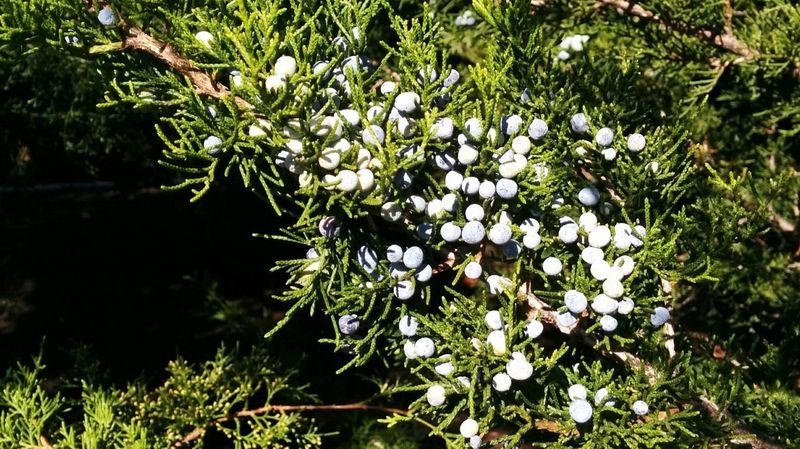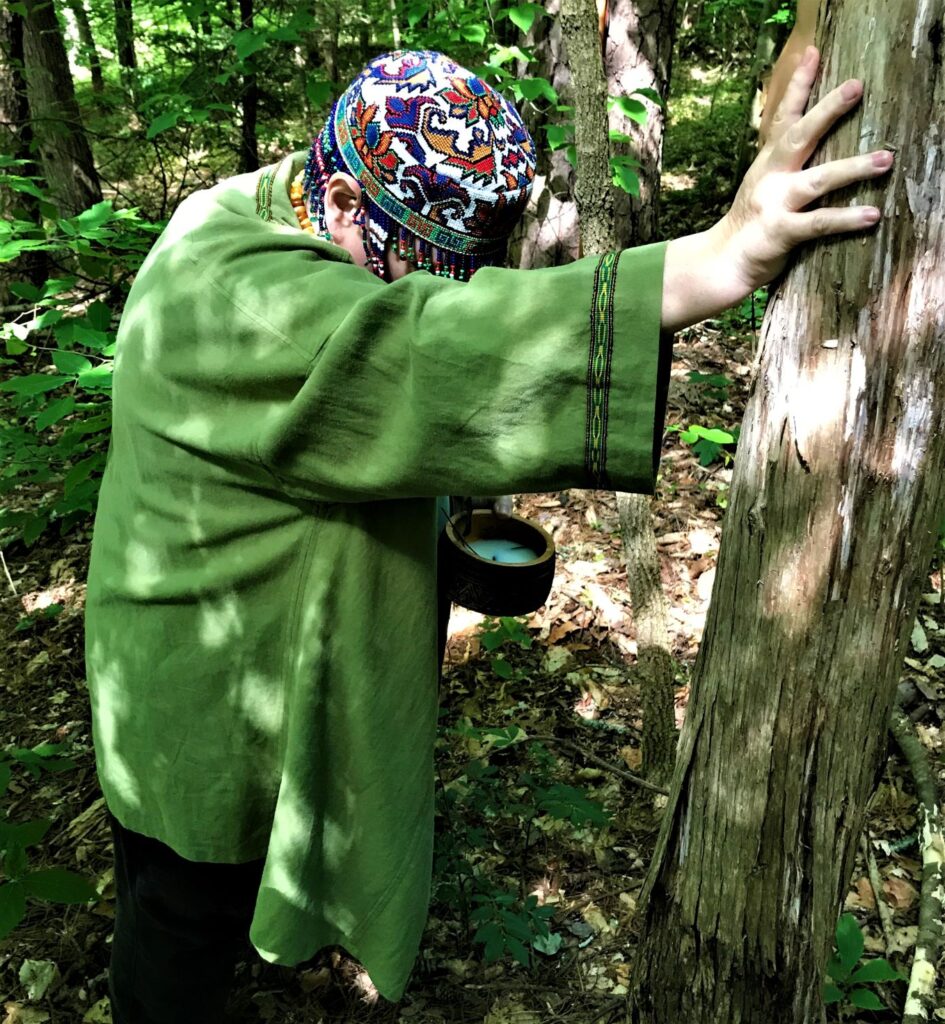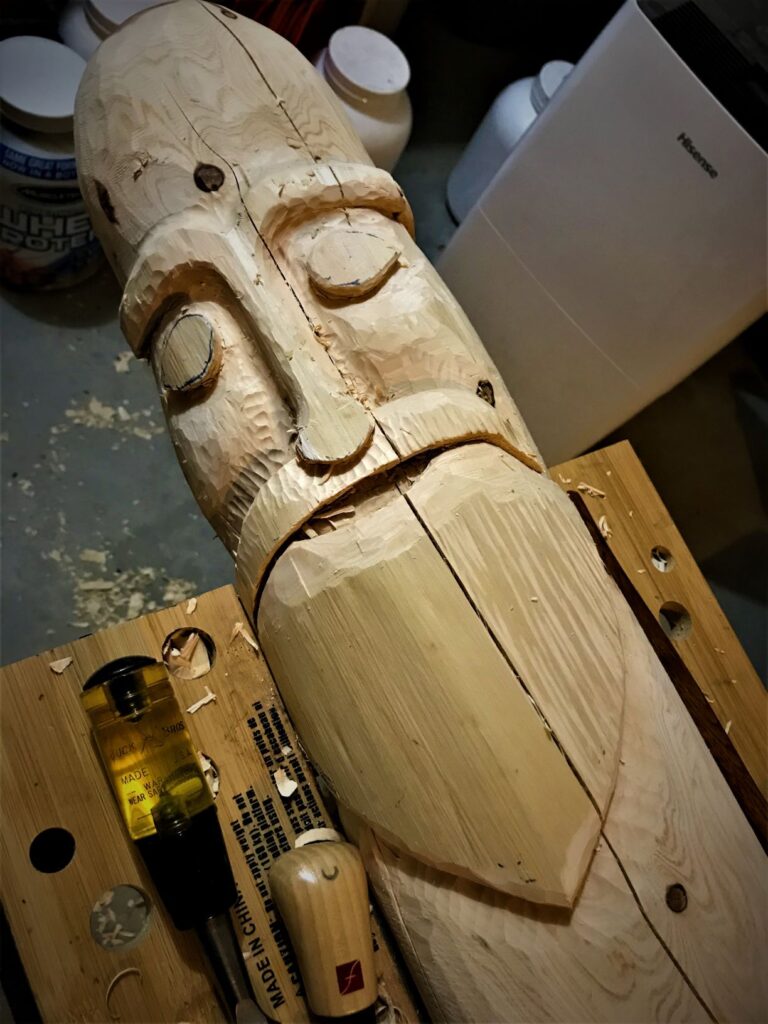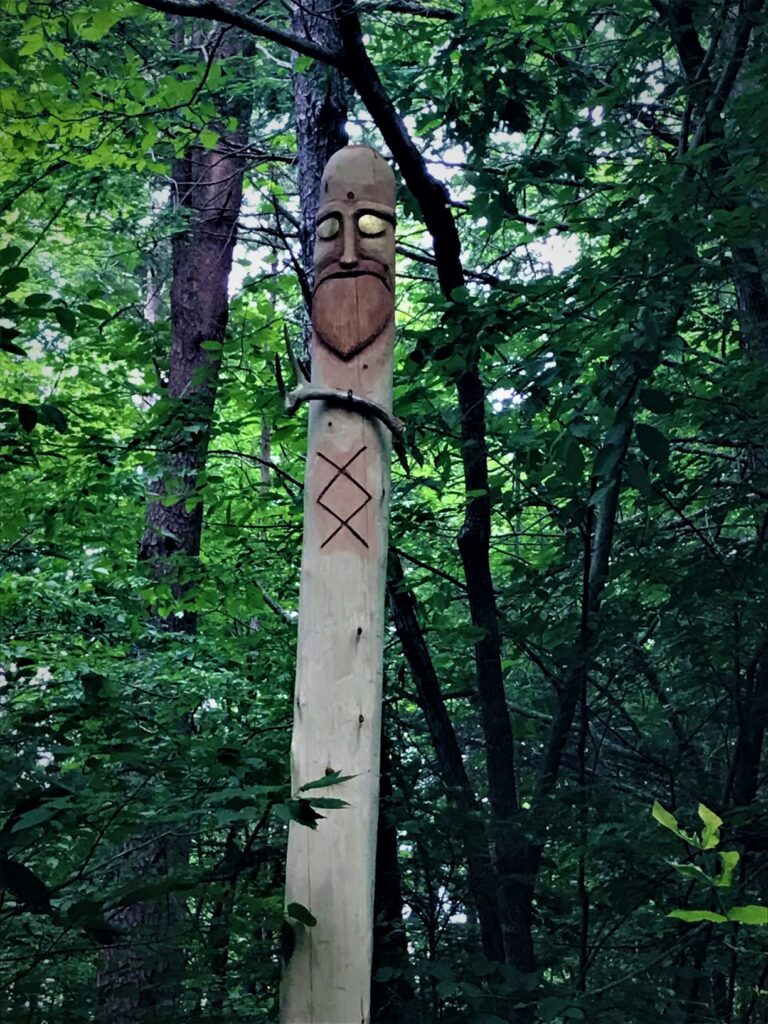
Almost all religions have their own particular icons and spiritual imagery. Among Norse, Germanic and Slavic people of the pre-conversion era, it was common to raise carved votive images of their revered gods. Often such godpoles, the term by which these are now known, served as a place of conversation with and offering to the represented deity. It seems likely that this practice was an outgrowth of the ancient practice of designating certain trees as holy. With a renewed interest in pre-Christian spiritual practices, modern Heathens are considering ways to honor the gods, and the carving and placing of godpoles is experiencing resurgence.
Here at TwoTrees, we have developed several sacred sites through our intentional interaction with the Landvaettir or spirit of the land, akin to the Roman genus loci. Each of these locations is physically unique and each lends itself to specific interaction with the Sacred. The first to be developed was a worship area located on the knee of a hill, a sun-dappled glade amidst tall pines and intermittent hardwoods. At this site we honor the Vanir, those gods associated with the fruitfulness of the year and the agricultural cycle, revering in particular Freyr and his twin sister Freya.
Our first godpoles were very simple and Freyr’s, being made of hickory, decayed quickly. While I’ve been doing smaller votive carvings, I’ve never undertaken something of size. Still, late last fall, I began to feel compelled to undertake a substantial replacement pole for the Lord of Sacrifice out of Eastern Red Cedar. While this fragrant, reddish wood is not related to Freyr in the lore, it has the advantage of being common here at TwoTrees and of resisting rot. Eric and I surveyed the hillside and found several trees of appropriate size and I dowsed each of them, seeking the best candidate. A tall, straight tree about 35 years old and close to 12” in diameter at the base indicated it was willing to be harvested.
At the beginning of the summer, in conjunction with the pandemic, I took on a student-in residence willing to exchange work on the land for spiritual instruction. As it happened, this young man was also being ‘courted’ by Freyr. Thus, one of his first tasks was to assist us in the ritual harvesting and preparation of the wood for Freyr’s godpole. As we always do before cutting a tree here at TwoTrees, I again asked the tree’s permission, made offerings and praised it, bound off the base of the trunk and asked the life force to depart the tree and flow outward into the surrounding ecosystem to benefit the land.

I laid my hands upon the trunk and felt the vital force slowly ebbing and when it had stilled, I stepped back and signaled Eric that the tree was ready to be felled. As he started the chainsaw, I began to drum, pushing any remaining energy into the earth. The tree swayed and fell gently onto a deep cushion of dead leaves and ferns. As I ever do, even when a tree is cut down out of necessity, I felt an ache and a sense of sadness. My student removed the branches and we realized we had wood for not one god-pole but two.
Freyr is a god of love and sacrifice, the Grain Lord who willingly gives his life each year so the people will thrive, only to be resurrected as he springs forth from the warming earth. The first step was to strip away the fibrous bark, symbolic of Freyr’s willingness to give of himself for others. Among many Native American cultures, cedar bark was an important resource, being finely shredded for use as absorbent filler in infants’ cradleboard, provide fire tinder, or twined into strong cordage. The sapwood beneath is ivory in color and faintly piney in fragrance, revealing a loosely spiral growth pattern, reminiscent of our DNA. Deeper in, the heartwood of cedar is deep rose and softly aromatic. As my student removed the bark in long strips and trimmed away at the many knots left by small branches, I sketched the face I planned to carve.
Freyr is often associated with phallic imagery, appropriate for a fertility god, so I roughed out a somewhat helmet shaped head that hinted at other symbolism. My previous carvings had all been in soft wood, no larger than 3” x 9”, so clearly I needed larger tools. I’d often watched my father, a master carver, but he’d also worked on small pieces, frequently carving with a pocketknife. Still, I acquired a set of wood gouges and chisels, recaned my tools with sacred smoke (the Northern Tradition equivalent of smudging) and blessed them before starting to carve. The work proceeded slowly. I found I was able to carve for about an hour each morning and afternoon before my back knotted up. Still, I persisted, often singing to Freyr as I unbound Him from the wood. Carving is a process of starting from the outside and working toward the inside, revealing the intended object as more and more material is removed.

I had chosen an image of Freyr based on many traditional Viking Age depictions, with a long, straight nose, wide, staring eyes, and a neatly trimmed mustache and beard. Bit by bit I chipped away, deepening the relief, shaping and detailing. I also marked out and carved the rune Inguz – associated with Freyr, sacrifice and harvest – further down the pole. The tale is told of how Freyr took advantage of the All-Father’s High Seat to spy out across the worlds, and while doing so, he saw a Jötun maiden and lost his heart. His attempts at wooing her were repeatedly rebuffed until at last he gave up his fine sword, enchanted and given to him by his own mother, to prove the depth of his love, gave it up knowing he would never again heave another with which to defend himself. In its place he took up an antler, another symbol of masculine potency.
While I was busy carving, my husband Eric, a sacred smith, forged a u-shaped iron staple which we would use to fasten an antler to the pole. As I neared completion of the carving, I also cut two almond shaped eyes from a sheet of bronze and applied them. To give the image warmth and presence, I ground red ocher, that rusty iron-based mineral our ancestors associated with blood and life force, then used the ruddy stain to tint the details of the carving. Finally, I cut out a groove to accept the antler and with Eric’s help, pinned it in place with the iron staple.

Our plan was to erect the pole at noon on the Summer Solstice, the moment of bright Sunna’s greatest potency. By this time it had become clear to all of us that my student had indeed been claimed by the Grain Lord and so he took responsibility for the raising of the pole. We offered beer to Thor, asking that the threatening thunder storm hold off long enough for us to complete our ceremony, and hallowed the hole dug to receive the pole with offerings of milk, honey and barley. Afterwards, we celebrated with a feast of foods associated with the Golden One: crisply roasted pork with steamed grains, glossy red cherries and in the sweet spirit of mid-summer, a rich lemon sour cream pound cake.
Gift of the cedar, Freyr’s godpole now stand proudly overlooking the glade. The second half rests downstairs, awaiting my tools to be transformed into a votive pole for Freyr’s twin sister, my Lady Freya.
Hail Freyr!